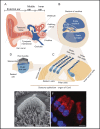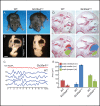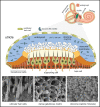Integration of human and mouse genetics reveals pendrin function in hearing and deafness
- PMID: 22116368
- PMCID: PMC3709173
- DOI: 10.1159/000335163
Integration of human and mouse genetics reveals pendrin function in hearing and deafness
Abstract
Genomic technology has completely changed the way in which we are able to diagnose human genetic mutations. Genomic techniques such as the polymerase chain reaction, linkage analysis, Sanger sequencing, and most recently, massively parallel sequencing, have allowed researchers and clinicians to identify mutations for patients with Pendred syndrome and DFNB4 non-syndromic hearing loss. While thus far most of the mutations have been in the SLC26A4 gene coding for the pendrin protein, other genetic mutations may contribute to these phenotypes as well. Furthermore, mouse models for deafness have been invaluable to help determine the mechanisms for SLC26A4-associated deafness. Further work in these areas of research will help define genotype-phenotype correlations and develop methods for therapy in the future.
Copyright © 2011 S. Karger AG, Basel.
Figures




Similar articles
-
Mutation analysis of SLC26A4 (Pendrin) gene in a Brazilian sample of hearing-impaired subjects.BMC Med Genet. 2018 May 8;19(1):73. doi: 10.1186/s12881-018-0585-x. BMC Med Genet. 2018. PMID: 29739340 Free PMC article.
-
Functional characterization of pendrin mutations found in the Israeli and Palestinian populations.Cell Physiol Biochem. 2011;28(3):477-84. doi: 10.1159/000335109. Epub 2011 Nov 18. Cell Physiol Biochem. 2011. PMID: 22116360 Free PMC article.
-
Molecular etiology of hearing impairment in Inner Mongolia: mutations in SLC26A4 gene and relevant phenotype analysis.J Transl Med. 2008 Nov 30;6:74. doi: 10.1186/1479-5876-6-74. J Transl Med. 2008. PMID: 19040761 Free PMC article.
-
Molecular and functional characterization of human pendrin and its allelic variants.Cell Physiol Biochem. 2011;28(3):451-66. doi: 10.1159/000335107. Epub 2011 Nov 18. Cell Physiol Biochem. 2011. PMID: 22116358 Review.
-
Pathogenetics of the human SLC26 transporters.Curr Med Chem. 2005;12(4):385-96. doi: 10.2174/0929867053363144. Curr Med Chem. 2005. PMID: 15720248 Review.
Cited by
-
Selection of Diagnostically Significant Regions of the SLC26A4 Gene Involved in Hearing Loss.Int J Mol Sci. 2022 Nov 3;23(21):13453. doi: 10.3390/ijms232113453. Int J Mol Sci. 2022. PMID: 36362242 Free PMC article.
-
FOXF2 is required for cochlear development in humans and mice.Hum Mol Genet. 2019 Apr 15;28(8):1286-1297. doi: 10.1093/hmg/ddy431. Hum Mol Genet. 2019. PMID: 30561639 Free PMC article.
-
Calcium selective channel TRPV6: Structure, function, and implications in health and disease.Gene. 2022 Apr 5;817:146192. doi: 10.1016/j.gene.2022.146192. Epub 2022 Jan 11. Gene. 2022. PMID: 35031425 Free PMC article. Review.
-
Atrophic thyroid follicles and inner ear defects reminiscent of cochlear hypothyroidism in Slc26a4-related deafness.Mamm Genome. 2014 Aug;25(7-8):304-16. doi: 10.1007/s00335-014-9515-1. Epub 2014 Apr 24. Mamm Genome. 2014. PMID: 24760582 Free PMC article.
-
Dissection of the Endolymphatic Sac from Mice.J Vis Exp. 2021 Mar 29;(169):10.3791/62375. doi: 10.3791/62375. J Vis Exp. 2021. PMID: 33843930 Free PMC article.
References
-
- Everett LA, Glaser B, Beck JC, Idol JR, Buchs A, Heyman M, Adawi F, Hazani E, Nassir E, Baxevanis AD, Sheffield VC, Green ED. Pendred syndrome is caused by mutations in a putative sulphate transporter gene (PDS) Nat Genet. 1997;17:411–422. - PubMed
-
- Shcheynikov N, Yang D, Wang Y, Zeng W, Karniski LP, So I, Wall SM, Muallem S. The Slc26a4 transporter functions as an electroneutral Cl-/I-/HCO3- exchanger: role of Slc26a4 and Slc26a6 in I- and HCO3-secretion and in regulation of CFTR in the parotid duct. J Physiol. 2008;586:3813–3824. - PMC - PubMed
Publication types
MeSH terms
Substances
Grants and funding
LinkOut - more resources
Full Text Sources
